John Deere
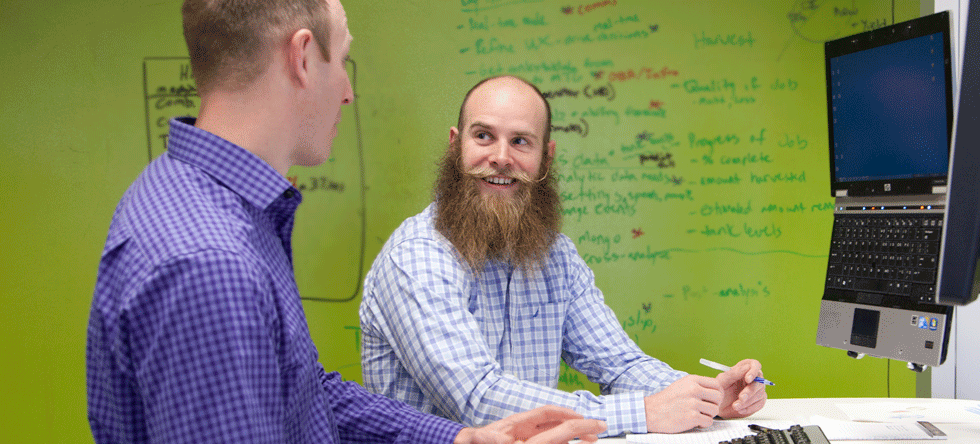
For John Deere, performance—in every aspect of its business—is what makes its familiar green and yellow equipment run. That’s especially true for the software developers responsible for making sure the company’s farm equipment outruns the competition.
That’s one of the reasons John Deere’s Intelligent Solutions Group (ISG) adopted an agile development process consisting of scores of scrum teams. An emerging work style most popular in information technology, scrum teams are small, intensely collaborative groups that work on short-term projects in close proximity—a setup designed to spur rapid innovation.
To facilitate the transition, John Deere replaced its cubicles with rectangular tables aligned in a benching layout that removes barriers to team interaction. Though this arrangement has some limitations, it works fairly well. Scrum team members can see each other always, chat whenever, and gather easily. And for any team discussion of a longish nature, they usually wander away to find either a room or whiteboard—acceptable, but not ideal.
“Brief stand-up meetings are common, and team members are always congregating around someone’s monitor,” says Casey Schrock, Director of Facilities for the Intelligent Solutions Group. “We’re already pretty good at collaboration, but we’re trying to figure out how we can leverage space design to make us even better.”
Looking for Insights
Better collaboration at John Deere means easier, faster, and more frequent. Seamless would be good, too, the kind of interaction that happens naturally without forethought—without, for instance, a scrum team having to reserve a meeting room away from its work area.
During a visit to the Herman Miller Design Yard in Holland, Michigan, Schrock caught sight of a prototype that showed promise in supporting the work style John Deere envisioned for its scrum teams. Called Locale, the line springs from Herman Miller research that identified a growing preference for casual, continual, and convenient collaboration, while still acknowledging that even collaborators sometimes need to be solitary.
As it happened, Herman Miller was seeking a customer to serve as a beta site for purposes of fine-tuning Locale; Schrock promptly volunteered John Deere.
“We were looking for visionaries, and they were looking for insights,” says Deanne Beckwith, a Herman Miller Solutions Integrator who served as project manager for the Deere beta installation. “John Deere realized that a new way of working called for something more ergonomically suited to the work they are doing.”
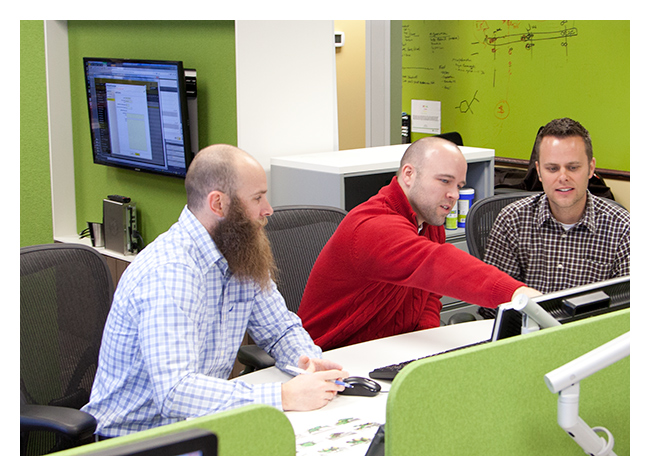
Generously sized and gently curved, Locale work surfaces encourage interaction. Individual work surfaces can serve as a meeting point on the spur of the moment.
A Neighborhood in the Living Office
Designers Sam Hecht and Kim Colin created Locale with the intention of allowing teams to transition easily between individual and group work in open plan office environments.
“Locale brings different parts of the office in proximity,” says Hecht, a partner with London design firm Industrial Facility. “You shouldn’t have to move to completely separate spaces to accommodate varied work styles.”
Locale uses a variety of elements—large height-adjustable work surfaces; mobile tables, screens, and easels; and cabinets for storage and display—to create custom settings for individual work and informal meetings.
The product dovetails with an emerging Herman Miller concept called Living Office, a holistic approach to helping individuals and organizations customize their methods tools and places of work to express and enable shared character and purpose.
As part of this approach, Herman Miller has identified 10 Modes of Work—workplace behaviors people engage in no matter what kind of work they do, or if they do it together or alone. Living Office provides people with a variety of settings, or spaces optimized to support these Modes of Work.
At John Deere, a small team of Intelligent Solutions Group managers are testing Locale in a 700-square-foot Clubhouse setting—a working neighborhood that gives project teams multiple points for individual and group tasks and the freedom to shift instantly and intuitively among them.
In one half of the space, work surfaces cantilever off a low, linear workbase that houses power and provides storage. This grouping of individual work points takes advantage of co-location to help drive work forward.
In the other half—just a couple steps away—mobile screens and a display unit define an interactive area containing a small table, whiteboards, and a large monitor. The compact space is near individual work points and is designed for brief meetings of small groups.
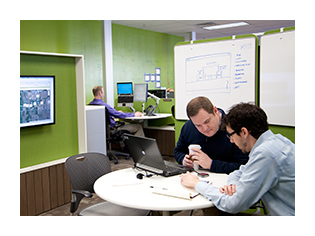
For meetings requiring a bit more than a desktop—more time, more room, more technology—team members gather in the adjacent collaboration space. Whiteboards and a large monitor provide options for sharing ideas.
“Everything you need is clustered together—just like in any close-knit neighborhood,” says Locale Product Manager Wendy Muth. “Though scrum teams are a natural for Locale,the product is designed for any highly collaborative team that needs to work in close proximity—product development, creative groups, even executive leadership.”
Instant Transition Between Individual and Group
The ISG managers assigned to the John Deere test site use Locale in as many different ways. One sits and focuses on his computer much of the day. Another mostly stands. The rest shift between sitting and standing by raising or lowering their work surface—whatever feels most comfortable or productive.
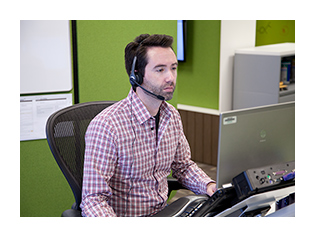
Locale provides easy transitions between group work requiring convenient collaboration and individual work requiring intense focus.
Screens and monitors between facing work surfaces provide a measure of privacy without jeopardizing proximity. “It’s easy to see and interact with team members, yet there’s still a sense of personal space,” Schrock says.
That sense of personal space is even keener because work surfaces are generously sized. Plus, there’s a gap of a foot or so between adjacent surfaces, enough space for team members to gather around one without disturbing their next-door colleague.
“Every work surface can become an instant meeting point,” Schrock says. Impromptu stand-up meetings are even easier because surfaces are not only height adjustable, but also cantilevered—there are no legs to obstruct movement as teammates congregate. They’re curved, too, resulting in a less rigid, more welcoming feel.
“The idea was to respond to research that found a certain tension between the need to work alone and the need to be with others in small, highly collaborative teams,” Muth says. “Locale is designed to relieve that tension. You’re working on your computer, someone comes up, you raise your desk, you pull others over—it’s about immediacy. Collaboration doesn’t have to be scheduled; it just happens.”
“If you have to think about collaborating, you’re losing time,” Schrock says. “The way our ISG teams work, there always seems to be this interplay between individual and group work. The faster we can transition between the two, the more efficient we can be.”
A Different Tack
Of course, not every interaction can take place around a desktop. For issues a bit more involved, team members simply step into the adjacent Locale collaboration space. “So close the transition feels second nature,” Schrock says.
Locale elements inside the space include a small table, a display unit that houses a large monitor on one side and a whiteboard on the other, and a pair of freestanding screens that add definition while supporting more whiteboards. In addition, the space offers a handful of stackable Caper chairs that team members move here and there as needed.
Initially, John Deere didn’t see much need for an adjacent collaboration space. The Intelligent Solutions Group had experimented a bit with lounge areas furnished with soft seating, but found they were rarely used.
A few conversations with Herman Miller contacts Wendy Muth and Deanne Beckwith persuaded Schrock to try a different tack with the help of Locale.
Further conversations with Brian Green, Research Lead in Herman Miller’s Insight and Exploration group, also piqued interest in a fresh approach. The resulting Locale collaboration space hits the sweet spot for the way ISG team members work together—less staid than a conference room, less casual than a lounge, and more engaging than either.
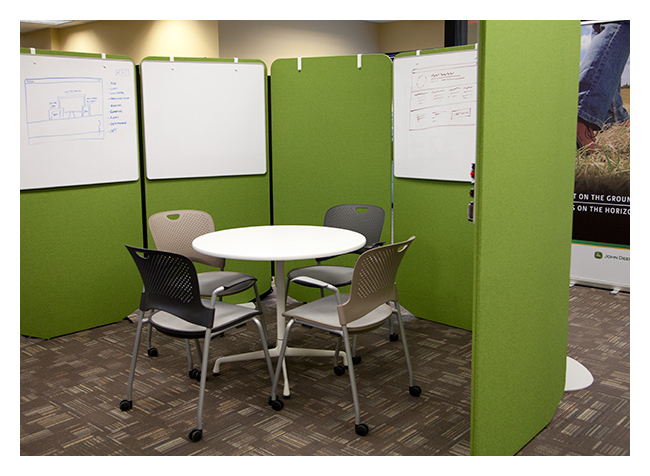
Freestanding screens with attached whiteboards give definition to the collaboration space, keeping it open enough to feel inviting and closed enough to feel private.
“I spent a lot of time talking with Brian about different installations he’s seen around the globe,” Schrock says. “He helped me understand why people work the way they do and how they can work more effectively.”
“Perceived ownership is important,” Green says. “We find that teams are far more likely to use a collaboration space when it’s clearly part of their environment and doesn’t need to be scheduled.”
The ISG team that owns the space gravitated to it immediately. “People use it all the time,” Schrock says. “Quick stand-up meetings, sit downs with two or three people, even larger groups that aren’t part of our subject team pull chairs in. Even if it’s not theirs, so to speak, they like that it doesn’t have to be booked and they can see when it’s open.”
Green suggests the popularity of the space stems partially from characteristics that communicate it’s intended for work, not just socializing. In this regard, one of the key features is ClickShare, a wireless collaboration system from Herman Miller alliance partner Barco. The system allows team members to display content from their laptops and smart devices on the large, shared monitor—instantly, wirelessly, and with just the click of a button. “ClickShare has really helped draw people in,” Schrock acknowledges.
What’s next for Locale at John Deere? Now that he’s seen how scrum team managers use Locale, Schrock would like to try it with a distinct scrum team itself. He’s also experimenting with layouts that would incorporate Locale into an upgrade planned for a couple hundred workstations on ISG’s Urbandale campus.
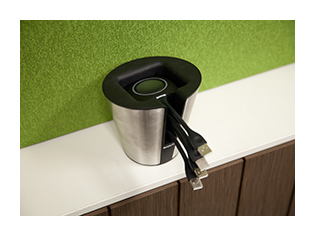
ClickShare buttons are stored in a ClickShare tray. When team members want to share content on the large monitor in the collaboration space, they simply grab a button, connect it to their laptop, and click.
“We’re intrigued to work with Herman Miller to identify ways to get people to collaborate better,” he says. “We certainly learned a lot about supporting our scrum teams from this experience.”
Photo credit: TJ Proechel
Company Informations:
Le Office Furniture Manufacturer
www.letbackrest.com
Address: No.12, Nanhua Road, LongJiang ,Shunde,Foshan, Guangdong, China (Mainland)
Email: sale@letbackrest.com
skype: kinmai2008

